5.4 THE WONDERS OF THE WORLD
During the Hellenistic Period travel increased, especially to those areas that had come under Greek rule. Persia had a decent road system that aided anyone attempting to move around in an area formerly inaccessible to the Greeks. During the Hellenistic period, several people listed the best places to visit. As the years went by, the more popular lists became known as the Wonders of the World. Here is the list created by Philo of Byzantium.1
It includes the approximate date that each monument was constructed.
- Great Pyramid of Giza Egypt (2584 BCE)
- Hanging Gardens of Babylon Babylon (c. 600 BCE)
- Temple of Artemis Ephesus (550 BCE)
- Statue of Zeus at Olympus Greece (435 BCE)
- Mausoleum at Halicarnassus (351 BCE)
- Colossus of Rhodes (292 BCE)
- Pharos Lighthouse at Alexandria Egypt (280 BCE)
Notice that these wonders are drawn from the Greek world. Many had existed for some time when the list was created. The last three were created in or around the Hellenistic period. Each of them displayed the elements expected in Hellenistic monuments.
Although The Pyramid of Giza is the only wonder that still exists, there are drawings and documents that discuss and outline the basic use of sculptural and architectural elements in many of the other buildings. It is, therefore, possible to gain a fair understanding of what these colossal monuments looked like and how they were used. In the cases of the lighthouse and the mausoleum at Halicarnassus, and we can still view the remnants of the structures that once decorated the mausoleum.
One of the Seven Wonders of the Ancient World is the Mausoleum of Halicarnassus (Bodrum), built for king Mausolos of Caria. Unfortunately there is not a lot left to see of this ancient and once magnificent tomb. It was named as one of the Seven Wonders of the Ancient World but now one must rely on imagination and models.
Mausolos ruled the kingdom of Caria in the western part of Asia Minor (Turkey) from 377 BCE. During his reign he transferred his capital from Mylasa to Halicarnassus. His ideas were never on a small scale and he set out to create a worthy capital city taxing the inhabitants heavily to cover the costs of fortifications and other grand projects.
Mausolos was married to his sister Artemisia, a common practice for rulers in those days, and they ruled until his death in 353 BC. Although brokenhearted, Artemisia set about to build a tribute to Mausolos. This was to be the finest tomb in the known world. The Mausoleum, standing at over 165’ in height, is described as being an enormous white marble tomb with ionic columns that formed a temple with a stepped pyramid roof. It was topped by a carriage containing statues of Mausolos and Artemisia drawn by four horses.
This stood relatively intact for almost 19 centuries until an earthquake in 1304 destroyed it. The Knights Hospitaller broke it up further in 1522 and used the pieces as building material for their castle. The site has pleasant gardens with excavations to the right and a covered arcade to the left. The arcade contains a copy of the famous frieze mainly recovered from the castle walls. The original was sent to the British Museum in London in 1846. Four original fragments on display were discovered more recently. Mausolos’ name is now associated with all stately tombs through the modern word Mausoleum.
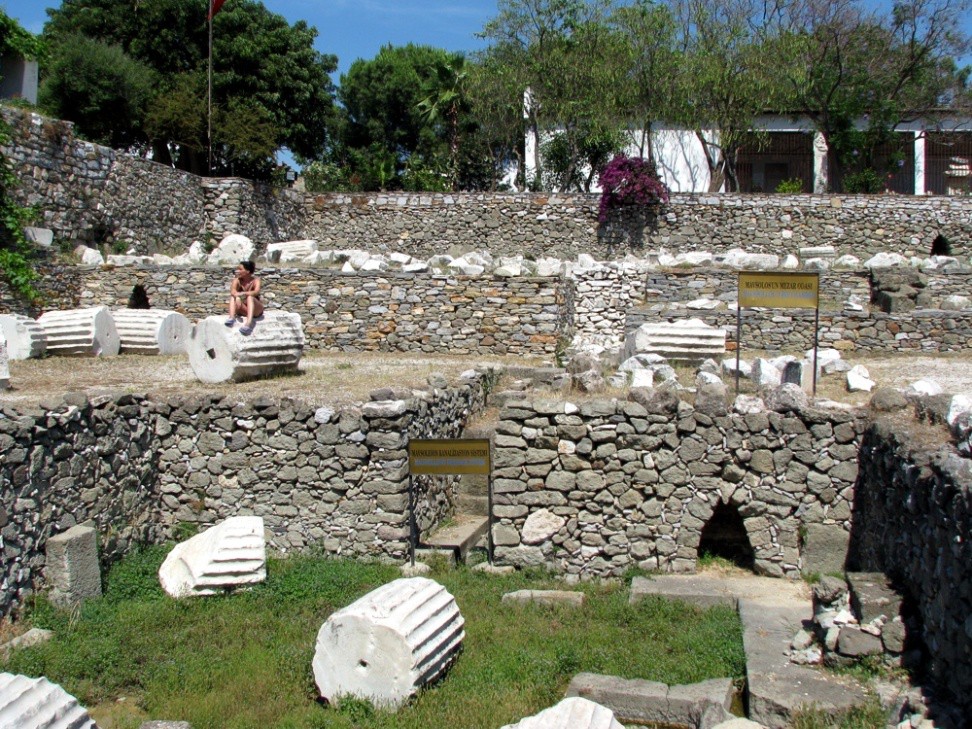
Notice that the mausoleum incorporates the Persian idea of a podium, or platform. This no doubt helped to aggrandize this king, who like rulers in Egypt chose to marry his sister and combine religion and politics. The columns of the building were ionic in style brought from northern Greece. The structure is topped by a pyramid shaped roof, which is crowned by a statue set, much like the Classical Charioteer. This time, however, the king himself rides the chariot with his sister-wife. Combining a minimum of three cultures’s building styles created the grandest mausoleum in the European world.
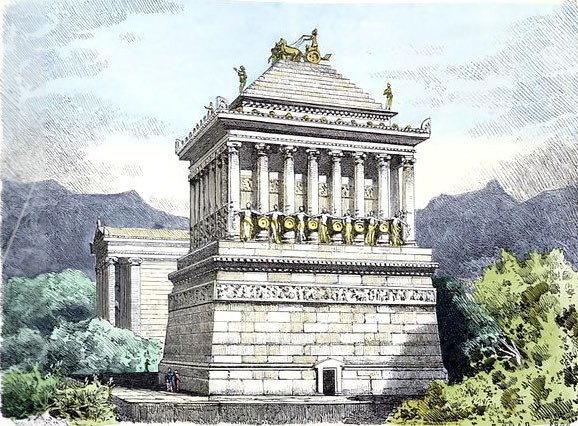
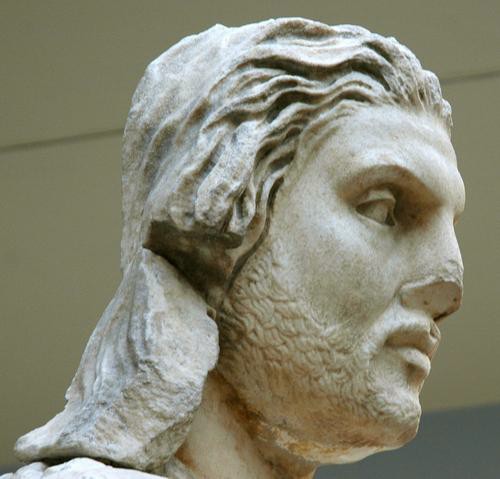
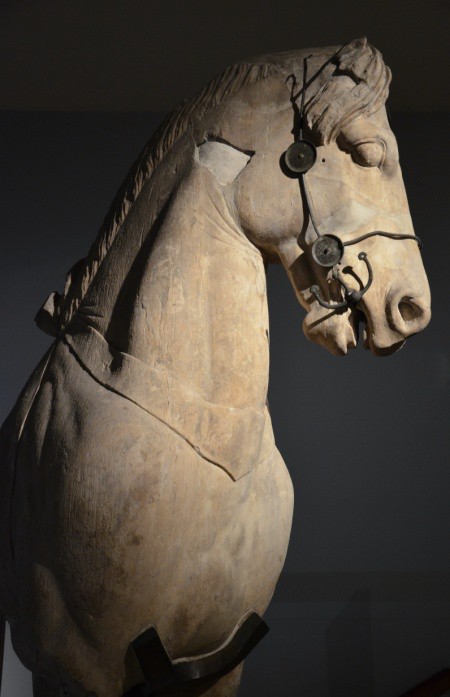
What is left of the sculpture that decorated this building also demonstrates Hellenistic styling. Notice that the image of the king’s head is handsome and strong looking. He considered himself a handsome brute but the image was likely idealized, none-the less. Although the king was Greek, he sported a beard, a style probably borrowed from the Persians. Even the horse is in a contrapposto pose. It is not preparing to move but is tossing his head; it is in action. This is a rare opportunity to view a Greek sculpture with the added bit and bridle. Other sculptures that remain also display motion.

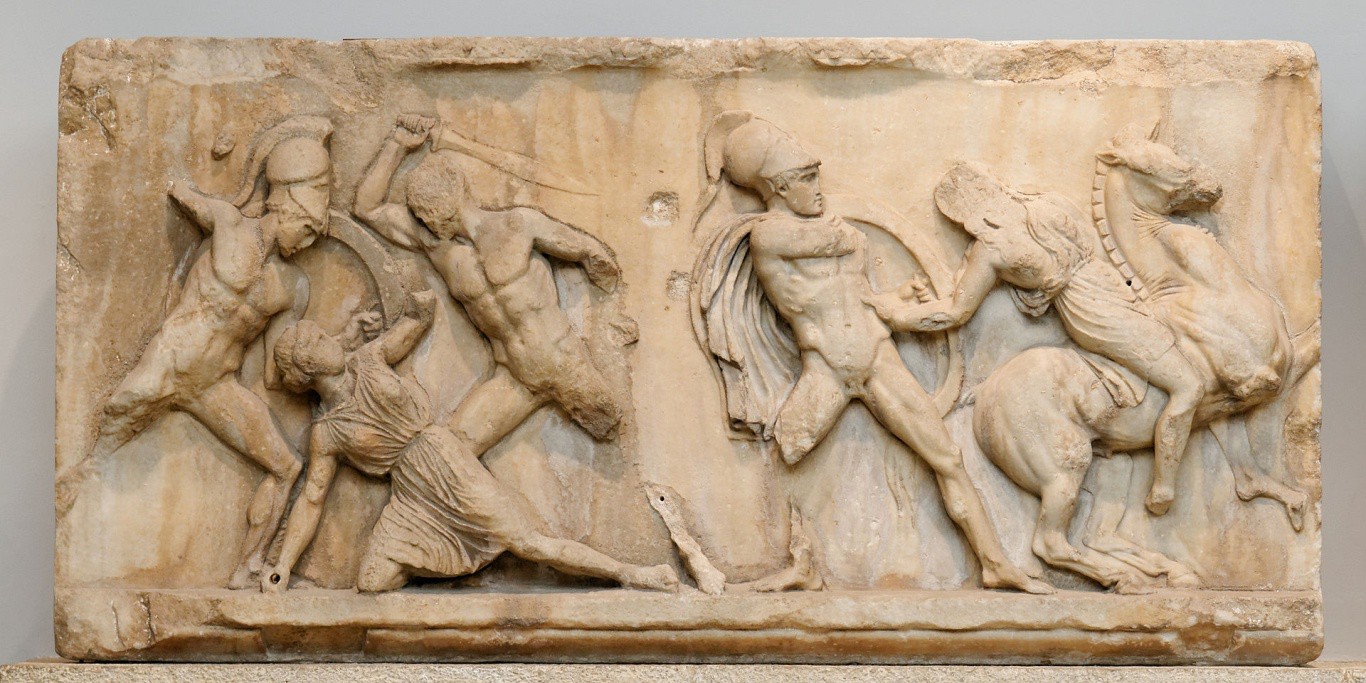
In the image above, strong diagonal lines indicate intense movement. The men’s bodies are idealistically muscular and flawless yet there is bloodshed, not an ideal element. In the image below, it seems as though there is a strong wind blowing. The movement of the clothing of both men and women adds to the feeling of excitement. The Amazonomachy was a war between the Greeks and the Amazons, an all female group of warriors.
Another Wonder of the World that was created during the Hellenistic period was the Faros Lighthouse at Alexandria in Egypt. What was left of the lighthouse after it began to sink into the sea seems to have been used to construct other buildings, which is why there is still something to look at. Most of what can be learned about the lighthouse comes from anecdotes and documents, however.
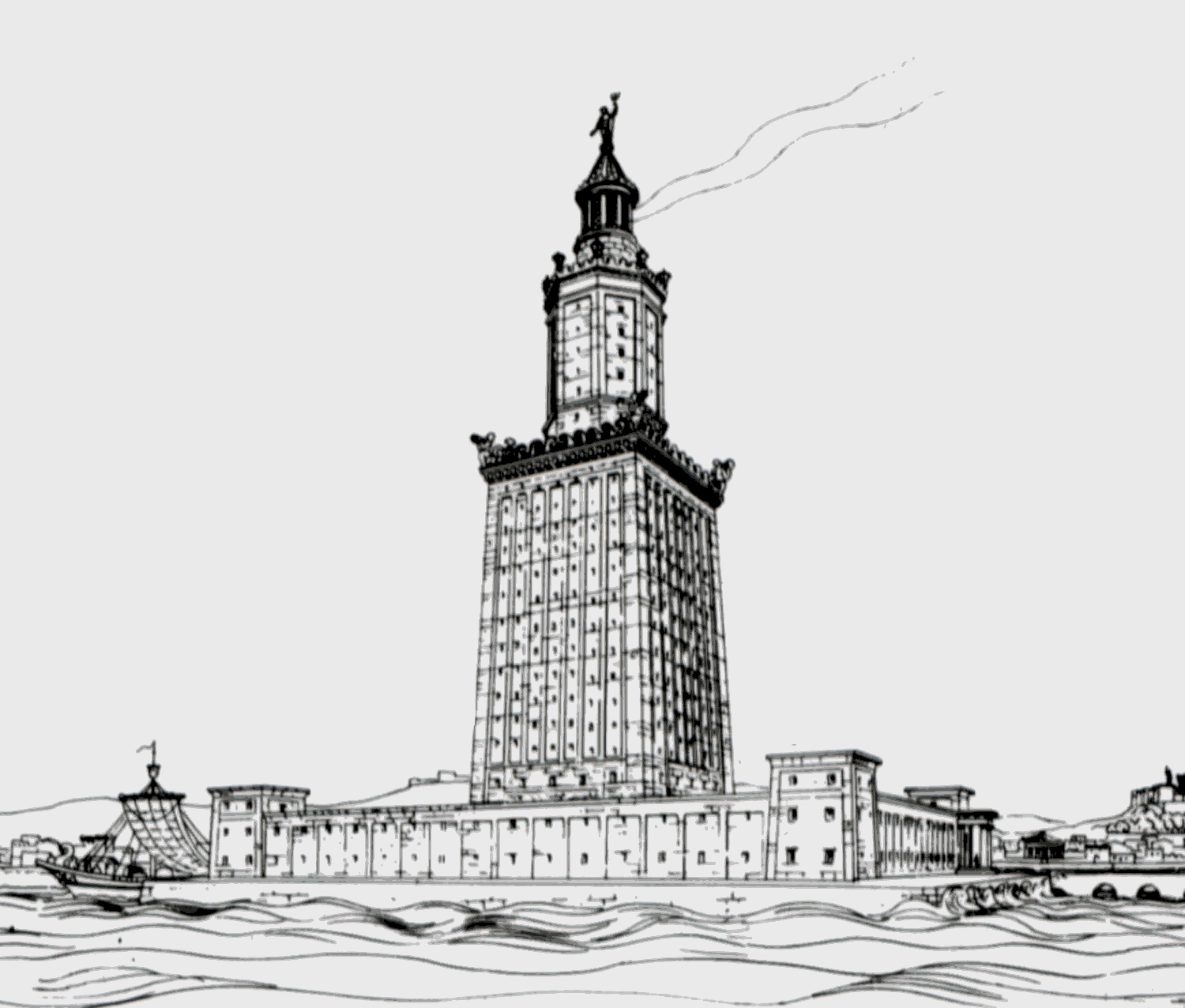
The strongest tie to the time period is that this lighthouse was built in a city named for Alexander the Great. It was impressive and huge, a testament to the importance of Alexander, who also visited the oracle in Egypt to validate his rule. In addition to the lighthouse, which was the largest and most impressive building found, there was a library built there that housed the most important Greek texts. It is unfortunate that the library was later destroyed.
The final monument that was created during the Hellenistic era was the Colossus at Rhodes. There are many descriptions of the colossus, but it only stood for about a quarter of a century so there are more questions than certainties. What is known for certain is that this was the largest free-standing sculpture known. Some said that it straddled the entrance to the bay, but that has been largely discounted due to what has been learned about physics. The statue was of a young man with a crown of light around his head, possibly a reference to the Mithric cult or to another Persian sun god. The Mithraic Mysteries, also known as Mithraism, were a mystery cult in the Roman world where followers worshipped the Indo-Iranian deity Mithras. This god was originally a Persian sun god. Note the mixture of cultural ideas. Rhodes was under Greek rule at the time that this statue was built. The statue was an idealized nude male, an idea that is quite Greek in origin. The size and materials, which took tons of bronze to construct, were typical of Hellenistic monuments. An earthquake felled the colossus and the people of the city refused to rebuild it because an oracle had warned against it.
Whether sculpture was monumental or personal, a mixture of cultures and ideas defined this period. Intense movement, ideal imagery and emotional content all combine to form this new art style, which would go on to influence the development of the Roman Empire. All of these are evident in the Mausoleum, even though it was built slightly before the time of Alexander. The Wars with Persia and ongoing settlement by the Greeks had already begun the spread of ideas that Alexander completed.
References:
1. Seven Wonders of the World. cmglee, Flappiefh, Nicolas M. Perrault [CC BY-SA (https://creativecommons.org/licenses/by-sa/4.0)]
2. Photo by bazylek100, CC BY 2.0, https://commons.wikimedia.org/wiki/File:Halicarnassus_Mausoleum.jpg Some text also taken from the file attached to the image in Wikimedia.
3. Public domain, https://commons.wikimedia.org/wiki/File:Mausoleum_at_Halicarnassus_by_Ferdinand_Knab_(1886)_cropped.png
4. Photo by Jona Lendering, Livius.org, CC0 1.0, Public domain, https://commons.wikimedia.org/wiki/ File:Mausoleum_ of_Halicarnassus, _Maussolus.jpg
5. Photo by Carole Raddato, CC BY SA 2.0, https://commons.wikimedia.org/wiki/File: Fragmentary_horse_from_the_colossal_four-horses_chariot_group_which_topped_the_podium_of_the_Mausoleum_at_Halicarnassus,_Mausoleum_at_Halicarnassus,_around_35 0_BC,_British_Museum_(17463831416).jpg
6. Photo by Marie-Lan Nguyen, CC-BY 2.5, https://commons.wikimedia.org/wiki/File:Amazon_Frieze_BM_GR_1865.7-23.1_n01.jpg
7. Photo by Marie-Lan Nguyen, CC-BY-2.5, https://commons.wikimedia.org/wiki/File:Amazon_Frieze_BM_GR1847.4-24.5_n01.jpg
8. Public domain, https://upload.wikimedia.org/wikipedia/commons/2/22/Lighthouse_-_Thiersch.png

